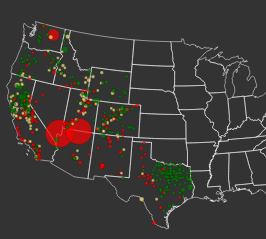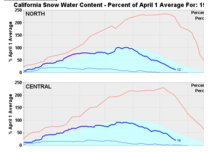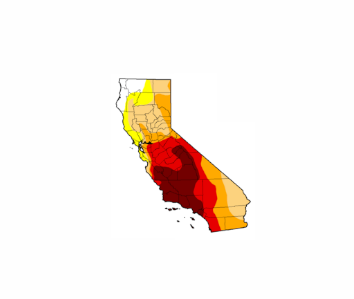California Drought 2011 - 2017
Persistent hot and dry weather led to years of acute drought in California from 2011 through 2017, an event worsened by climate change. The fingerprint of climate change is seen in rising temperatures and changing atmospheric patterns conducive to diminishing rains. The first link is firmly established, and there is a considerable and growing body of evidence supporting the second. Weather records tend to be broken when both natural and human-driven trends run in the same direction, in this case towards warmer temperatures that are increasing California drought risk.
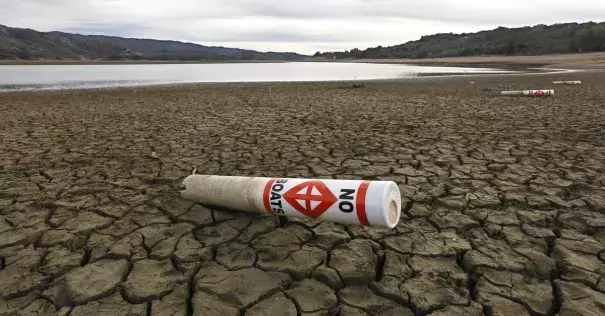
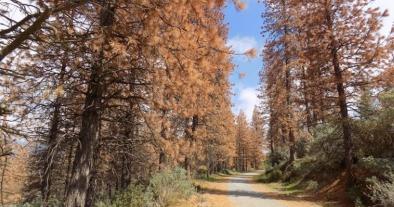
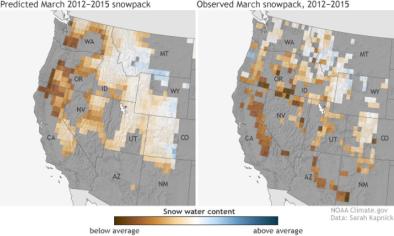
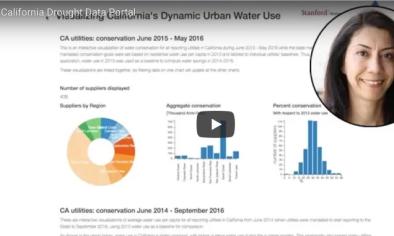
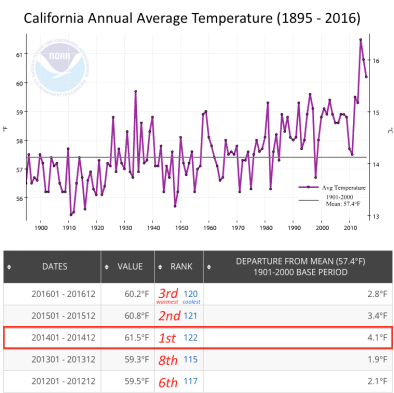

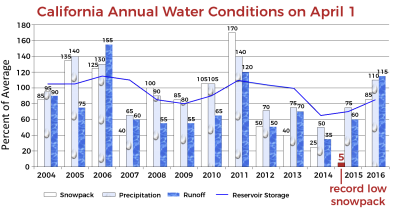
Climate change detection and attribution studies identify the fingerprint of climate change on the California drought
- (Wang et al. 2017): The dramatic switch from extreme drought to severe flooding in California, and the accompanying flip from atmospheric ridge to trough in the northeastern Pacific, exemplifies the pathways to an intensified water cycle under a warming climate.[1]
- (Berg and Hall 2017): Climate change reduced California's snowpack by 25 percent during the 2011-2015 drought.[2]
- (Mote et al. 2016): Climate change exacerbated snow drought for Washington, Oregon, and California in 2015.[3]
- (Seager et al. 2015): Climate change-driven warmer temperatures affected the 2011-2014 drought by drying soils. The precipitation deficits in winter were largely due to sea surface temperature anomalies and atmospheric variability.[4]
- (Williams et al. 2015): Climate change-driven warming was responsible for 8-27 percent of the low soil moisture in the California drought in 2012-2014.[5]
- (Shukla et al. 2015): It is very likely (80 percent chance) that climate change made the 2014 CA drought worse. Specifically, without warmer temperatures from climate change, there would have been higher snowpack moisture content (snow water equivalent) and higher spring/summer streamflow from snowmelt.[6]
- (Diffenbaugh, Swain, and Touma 2015): Climate change has doubled the frequency of droughts in California, just from warmer temperatures. Low precipitation alone is less likely to cause a severe drought, yet due to climate change, dry years are now twice as likely to also be warm years.[7]
- (Griffin and Anchukaitis 2014): Record-high temperatures exacerbated the 2012-2014 drought by 36 percent. While precipitation was low, it was not unprecedented, yet the drought was the most severe on record - explained by high temperatures.[8]
- (AghaKouchak et al. 2014): Climate change-driven warming made the 2014 California drought more severe. In general, it has also increased the likelihood of low precipitation and high temperatures occurring at the same time - a recipe for severe droughts.[9]
- (Wang and Schubert 2014): Two effects of climate change - dynamic (related to the northward shift of storm tracks) and thermodyamic (related to more moisture in the atmosphere) - counteract each other, meaning the net effect of climate change on CA winter precipitation is negligible.[10]
- (Swain et al. 2014): Climate change at least doubled the likelihood of the high pressure system that 'blocked' rain from coming to CA in 2013 (the "ridiculously resilient ridge").[11]
- (Wang et al. 2014): Climate change may have increased the east-west winter 'dipole' in North America, which is linked to the 'ridiculously resilient ridge.' Climate change, thus, had a traceable influence on the low precipitation.[12]
California drought: Temperature on the rise
The most infamous, long-lasting California drought of recent history began October 1, 2011 — the start of the 2012 water year — and lasted through 2016. During this five-year period, the state endured record-breaking high temperatures and scant rainfall, resulting in drought conditions unprecedented in at least 1,200 years.[8] On January 17, 2014 California State Governor, Jerry Brown, declared a drought state of emergency.
 The year 2014 ended as California’s driest and warmest since records began in 1895.[13][14] In 2015, the state experienced its second-driest and second-warmest year on record.[14] In May 2014, for the first time on record, 100 percent of California was experiencing drought conditions ranked “severe” or worse.[15][16] From 2012 to 2015, Lake Tahoe warmed at an average rate of 0.3°F per year—15 times faster than the long-term warming rate.[17]
The year 2014 ended as California’s driest and warmest since records began in 1895.[13][14] In 2015, the state experienced its second-driest and second-warmest year on record.[14] In May 2014, for the first time on record, 100 percent of California was experiencing drought conditions ranked “severe” or worse.[15][16] From 2012 to 2015, Lake Tahoe warmed at an average rate of 0.3°F per year—15 times faster than the long-term warming rate.[17]
Among the major consequences of the extreme heat and drought was an unprecedented tree die-off event, which has elevated California’s wildfire risk. In November 2016, the US Forest Service announced that an estimated 102 million trees died in California since 2010, with 62 million deaths recorded in 2016 alone.[18]
Many large wildfires during California's 2016 season were exacerbated by dried out fuels and record-breaking temperatures, including the Soberanes fire, which burned 132,127 acres, becoming the costliest firefight in US history at $260 million US dollars.[19]
The record warmth in recent years caps a period of persistent and unusual warmth, which has lasted over three decades.
A paleoclimate study found that, while precipitation levels throughout the drought were extremely low, it was largely the remarkable, record-high temperatures that made this drought stand out as the worst to hit the area in 1,200 years.[8]
Dr. Valerie Trouet, Assistant Professor in the Laboratory of Tree-Ring Research at the University of Arizona, explains:
What we are seeing now is fundamentally different from previous mega-droughts, which were driven largely by precipitation. Now, thanks to higher temperatures driven by climate change, droughts are increasingly temperature-driven.
Snowpack loss and drier soils
The rising average temperature in California, combined with lower-than-average rain and snowfall during the state’s rainy season, has reduced the wintertime snowpack that provides about a third of the state’s total water supply.[20]
Snowpack levels stood at or near record lows during the three consecutive winters of 2013, 2014 and 2015.[21] The statewide snowpack on April 1, 2015 held only 5 percent of the average water content on that date in records dating to 1950, leaving virtually no water to replenish state reservoirs.[21][22]
Warmer conditions mean that mountain snow melts earlier, more precipitation falls as rain instead of snow, and soils dry out faster. The winter of 2014 set a new seasonal record at 4.4°F (2.4°C) above the 20th century average, until 2015 bested that record by 1.5°F (0.83°C), or 5.9°F (3.3°C) above average.
Despite a strong El Niño during the winter of 2015-2016—conditions that have historically brought above average water to the state—rain and snowfall totals were barely above the long-term average.
Diminishing rains
There is now considerable evidence that climate change was at least partly responsible for the dramatic fall-off in precipitation during the winter rainy seasons of 2013/14 and 2014/15. Research led by Daniel Swain at Stanford University linked the unprecedented high-pressure weather pattern that blocked storms from California, known as the “ridiculously resilient ridge,”[23] to climate change. Others have also identified the fingerprint of global warming in the emergent high-pressure pattern.[12]
In 2013 and 2014, a high-pressure zone formed over the Pacific Ocean, diverting precipitation towards Alaska[24] (where the record warmth and precipitation caused avalanches).[25] While these zones are common, they normally change position quickly.
In contrast, the stability of this particular high-pressure “ridge” was unprecedented in modern weather records, held by a large, static bend in the jet stream.[26] The ridge blocked storms from reaching the state for almost all of the 2013/14 rainy season.[23] A similar high-pressure ridge returned during the 2014/15 rainy season, bringing well above-normal temperatures and well below-normal precipitation.
Many recent studies connect the changing weather patterns that diverted precipitation from the state to climate change. A May 2014 study looking at the high-pressure ridge found that, “[T]here is a traceable anthropogenic warming footprint in the enormous intensity of the anomalous ridge during winter 2013–2014 and the associated drought.”[12]
A September 2014 study led by Swain also links the ridge to climate change.[11]
The basic science regarding how global warming affects changes in atmospheric circulation is still being established, in particular on the question of how changes in circulation affect the weather patterns that steer storms. However, recent observations of lower-than-average precipitation are consistent with earlier forecasts.
A 2005 study predicted the impact of Arctic warming on California’s precipitation.[27] Projections from climate models produced a high-pressure ridge exactly like the one that California experienced.[27]
Finally, a study from October 2014 added to the science linking such high-pressure zones to extreme low precipitation in California.[28] Looking over the past century, total annual precipitation in California has declined slightly. Since 2000, precipitation has been below average in eleven of sixteen years.
The rest of the picture re: California drought
One of the hallmarks of climate change is that, on average, wet regions are getting wetter and dry regions are getting drier.[29] The Southwestern United States is one such dry region, and the Colorado River (which provides much of the water used in Southern California), is experiencing drought conditions “nearly unrivaled in 1,250 years."[30][31] The fingerprint of global warming has been found in the climate change contribution to the severity and duration of the recent drought afflicting the Southwest.[32] The Rocky Mountains are unable to provide the water that Southern California needs, just as the Sierra Nevada cannot provide relief for Northern California.
As hotter temperatures dry out crops and precipitation is scarce, groundwater withdrawals increase. An August 2014 study finds that the greater demands on the groundwater supply and the rapid rate of depletion may threaten the groundwater supply in multiple Western states for many years to come.[31]
Groundwater has an immensely long rate of recharge, and according to this research, the rate of groundwater depletion during the drought is almost six times greater than that of surface water. This has many repercussions for the farmers, businesses, and homes that depend on groundwater for survival. It also contributes to land subsidence, which has reached historically high rates of over one foot per year in some areas.[33]
Related Content


